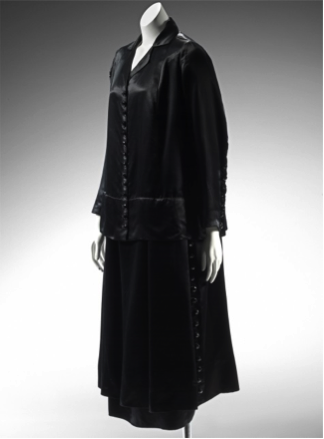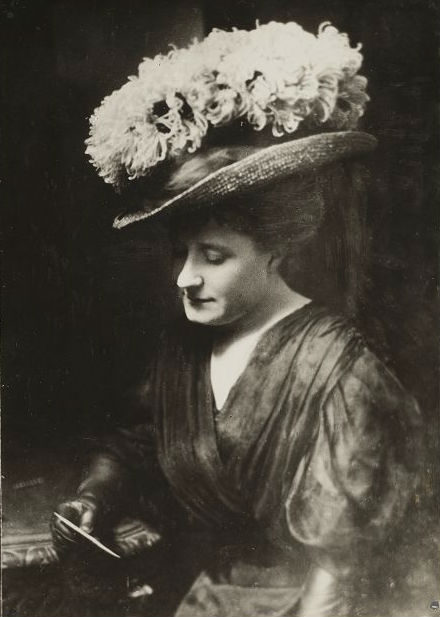Jacket and dress by Chanel
Download

Gabrielle Chanel (French, 1883–1971)
Jacket and dress (spring–summer 1920)
black silk satin, faceted glass buttons
Grainger Museum
University of Melbourne
04.6816

Grainger Museum, University of Melbourne
This jacket and dress ensemble was bought by Percy Grainger’s mother, Rose Grainger, from New York boutique La Mode chez Tappé, in 1920. Percy’s high esteem for his mother and her influence on his life and career are demonstrated by the way he chose to represent her throughout his museum collection. The costume collection, which comprises approximately 900 items, is of particular significance in this respect, as its content neatly encapsulates Rose’s aesthetic taste, social attitudes and cultural interests. It contains many important examples of late-19th and early 20th-century haute couture, such as this outfit designed by Gabrielle ‘Coco’ Chanel.
Coco Chanel had a modernist approach to clothing design, favouring functionality over flamboyance. World War I saw a dramatic raising of women’s hemlines, for improved practicality. Chanel built her image and her career around the sophisticated and innovative use of what is a traditional colour for mourning: black. This jacket and dress ensemble is an early and important example of her work. It is a compelling outfit for the metropolis, striking the right note for a woman negotiating the hubbub of social interaction and cities around the globe.
Teaching ideas
The University of Melbourne’s curriculum is rich and varied, and changes from year to year. For more teaching ideas, contact a collection manager.
Avant-Garde and Postmodern Art
Examine the ways in which fashion designers and fashion houses incorporated or responded to the conditions of modernity.
Concepts and Creativity
Visit the Grainger Museum exhibitions to consider performing arts practices in a broad cultural and historic perspective of creative endeavours, including (but not limited to) visual art, architecture and performance in all forms.
The Great War, 1914 to 1918
Explore women’s fashion, to consider to what extent the Great War transformed social and moral norms, gender, race and class relations, and relationships in the global economy.
City Cultures
Explore and analyse questions of mobility, social identities, post-industrial economies and creative industries; consider how cities have become central to our theoretical understanding of contemporary cultures. Look at objects of fashion in the analysis of cultures and their representations.
Conservation and Object-Based Learning
Examine and discuss the history and manufacture of traditional and modern materials, their properties and behaviour, and the processes of their chemical and physical deterioration in cultural materials. Extract evidence from the Grainger Museum’s costume collection on its materials, techniques and wider values.
Knowledge, Learning and Culture
Visit the Grainger Museum exhibitions and consider historical, social, political and cultural influences on knowledge, and the analysis of information and ideas from multiple perspectives.
Encounters with Writing
Use objects such as clothes as memory and creative triggers to initiate and develop detailed knowledge in self-initiated creative writing projects.
Exhibition Management
Understand the complexities of exhibition management at the Grainger Museum, including costume, art, archival and social history displays, and also the display of Grainger’s ‘lust branch’ material. Examine the Grainger Museum for a venue analysis assignment.
Intersecting objects
-

Young Cosmopolitans, Best & Co.
Dress belonging to Ella Grainger, 1950s
cotton, tulle (meshed textile), plastic
Grainger Museum
University of Melbourne
04.5683 -

Rembrandt Studio (Christchurch, New Zealand)
Rose Grainger, 1909 (second Australasian concert tour)
silver gelatine photographic print
15.2 × 10.9 cm
Grainger Museum
University of Melbourne
99.2500
To learn more, visit the Grainger Museum website.
References
Roger Leong, ‘A demure nonchalance’, in Brian Allison & Jennifer Hill (eds), Hoardings: Exceptional, exotic and commonplace, Grainger Museum, University of Melbourne, 2013, p. 28.
Roger Leong et al., Black in fashion: Mourning to night, Melbourne: National Gallery of Victoria, 2008, p. 40.